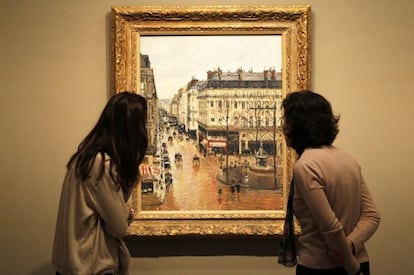Painting his way to the future
The Thyssen-Bornemisza Museum is hosting a Camille Pissarro exhibition It is first devoted to the pioneering father figure of Impressionism to be held in Spain

It is not often that one gets the opportunity to clearly contemplate the watershed moment that marked the transition from the old to the new, from the before to the after, from what was to what will be.
But this miracle instant in artistic evolution is there for everyone to see at the Pissarro exhibition that opened at the Thyssen Museum in Madrid on Tuesday, where it will remain on display until September 15. After that, the show moves on to CaixaForum in Barcelona. The show is the first comprehensive exhibition devoted to the French Impressionist ever mounted in Spain.
Pissarro's personal transition is encapsulated in the distance separating the 1867 painting The Banks of the Oise from the 1870 work Louveciennes. In between, the salient interpreter of the teachings of Jean-Baptiste-Camille Corot, Gustave Courbet and Charles-François Daubigny becomes an early herald of the Impressionist revolution. His brush strokes break up, the light becomes spacious, and the colors expand into new dimensions.
Camille Pissarro (1830-1903) never abandoned his Impressionist creed. Nor did he turn his back on "the boys" - Monet, Cézanne, Gauguin, Renoir, the fellow painters who were born a decade later and had very different personal backgrounds from himself. The son of a Portuguese-Jewish father and a Creole mother, Pissarro was born on the island of St Thomas, in the Danish West Indies (now the US Virgin Islands), and learned to paint in Paris and Venezuela before retiring to the country, where he led a quiet life until he was forced back to the city.
Pissarro learned to paint in Paris and Venezuela before retiring to the country
Pissarro was a father figure, an older brother and a friend to these and other painters such as Van Gogh. He was at once a master to and a student of Monet, who helped him see reality in a different way (witness Louveciennes), and Cézanne, whose geometric compositions found their way into Pissarro's Le chemin d'Ennery (1874) - the only work here on loan from Paris's Musée d'Orsay.
Pissarro's good nature is indicated by the fact that he was the only representative of modern painting to participate in all eight Impressionist exhibitions held from 1874 to 1886. He also drafted the statutes of the cooperative project with which the group attempted to free itself from the constraints of the art market in the 1870s, when the Prussian War caused an economic crisis in France. And he did all this before the group's most notable members became money-making machines, and long before Impressionist exhibitions became synonymous with popular success, as the folks at the Thyssen well know.
Exhibition curators Guillermo Solana and Paula Luengo were careful to avoid the temptation of using the magic word that draws the masses: the show is simply called "Pissarro," and not, say, "Pissarro, the first Impressionist." "I believe in instantly recognizable names, and this is one of them," said Solana last week, as the exhibition was being set up. But he was probably still smarting from the reprimand he got from some quarters after titling a recent show about landscape art Impressionism and Open-Air Painting, even though it spanned a broader timeframe than the one encompassing the art movement.
That controversy is not the only thing disturbing the peace of this sensational show. One of the urban landscapes on display, Rue Saint-Honoré in the Afternoon. Effect of Rain (1897), is at the center of an ownership dispute. Though formally the property of the Thyssen collection, and thus of the Spanish state, there is a claim on it by the descendants of Lilly Cassirer Neubauer, a Jewish woman who fled Nazi Germany but was forced to relinquish ownership of the painting to obtain an exit visa. After the war, she reclaimed the canvas in court, and in 1958 the German government recognized her as the legal owner and gave her 120,000 marks in compensation.
One of the urban landscapes on display is at the center of an ownership dispute
After the Thyssen foundation purchased it in good faith and hung it inside the museum, Lilly's grandson Claude Cassirer, a photographer who died in 2010, claimed back the work, which is valued at 13.7 million euros. In May 2012, the claim was dismissed by a California court, but the decision could be appealed.
The exhibition is organized in chronological order, beginning by showing a painter's palette turned into a work of art. A self-portrait of the artist marks the beginning of a journey to 19th-century France, from Louveciennes to Pontoise and Éragny, the quintessence of the sleepy countryside that Pissarro so adored, although he was not immune to the industrial beauty of Rouen and Le Havre or the bustle of Paris.
"There is a fundamental change between the artist of the countryside and the artist of the city, where he moved when an eye infection forced him to stop painting in the open air," explains Solana. Contemplating the world from the window of a hotel room increased the ageing Pissarro's melancholy mood, resulting in the fog that covers paintings such as his famous depiction of Charing Cross in London. In the distance, alert visitors might get a glimpse of the fast-approaching 20th century with its avant-garde ferocity and voracious self-destructiveness.







































